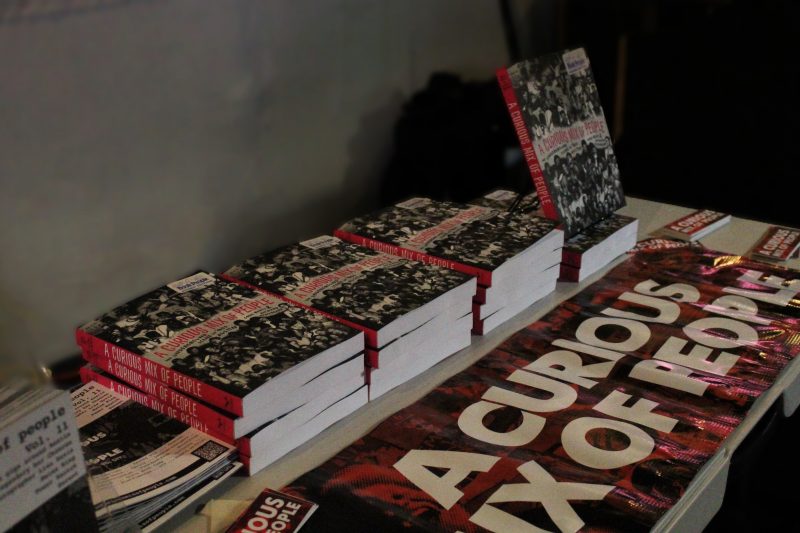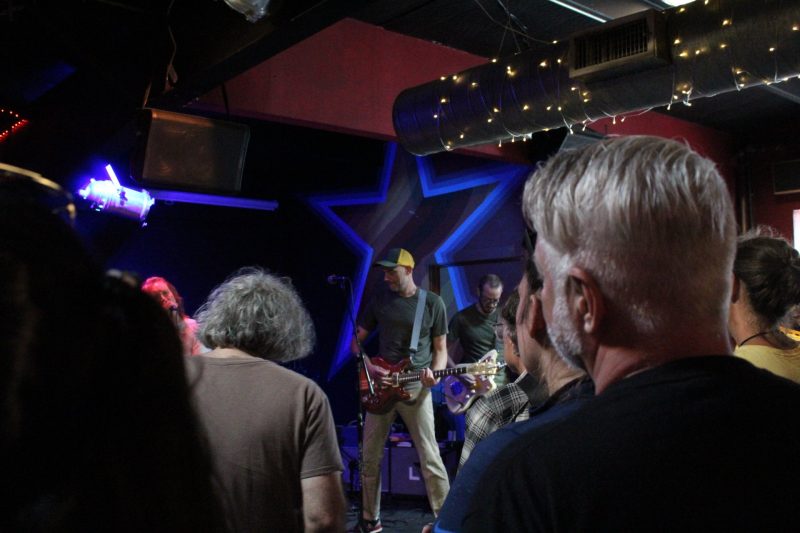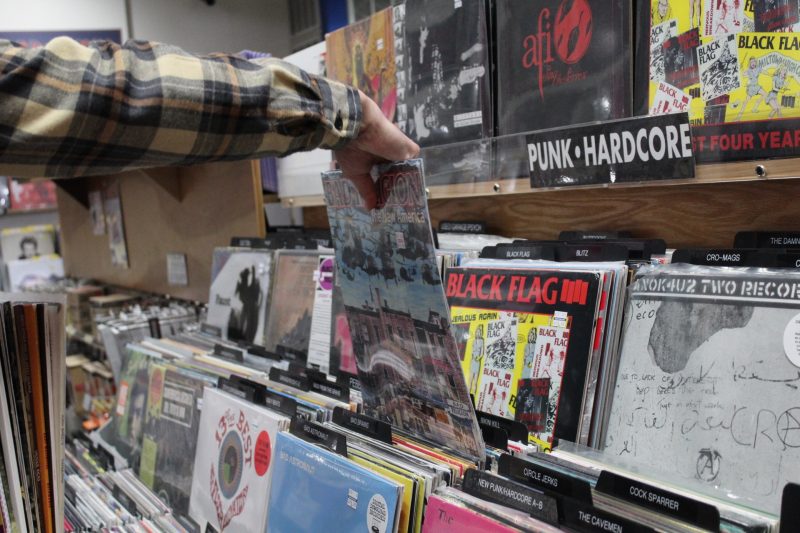The Enduring Spirit of Austin’s Underground Music Scene
By Anissa Sanchez
Reporting Texas
Dim lighting illuminated the grunginess of The Parlor in Hyde Park on a recent Saturday, shedding slivers of light on a book release party for “A Curious Mix of People.” The scene was more akin to a high school reunion that united old friends and bandmates – which is exactly what authors Greg Beets and Richard Whymark aimed to celebrate with their new book.
“I’ve had several people come up to me and say it’s kind of like our yearbook,” Beets said. “It’s capturing a lot of stuff that happened as the internet was starting to take over.”
The book celebrates and chronicles Austin’s music scene in the 1990s, before the city’s rapid growth in the early dot-com days and continued sprawl of the past two decades. Since the 1990s, an undeniable evolution has taken place within the Live Music Capital of the World. It has revealed both continuities and notable shifts between then and the present day. Or, as the book’s authors said, “As the city grew, the local music scene couldn’t help but become less inwardly focused.”
While the ‘90s were characterized by a DIY ethos, Austin’s underground scene today thrives among a rapidly changing urban landscape and a digital age that has transformed the way music is discovered and consumed.
“What’s changed is not the scene; it’s that people from outside the scene now see us in a way that we never got seen,” said Raoul Hernandez, contributor for the Austin Chronicle and now assistant professor in journalism at the University of Texas. “I think the DIY spirit is still more or less the same. We are a town defined by youth culture in part because of UT and other universities. It generates music, and it’s still a good incubator for music.”
Published by UT Press in October, “A Curious Mix of People” began as a documentary by longtime musician and artist Chepo Peña – a key figure in conducting a slew of interviews with the scene’s main characters. After several years of working on the documentary, the group quickly realized how broad the creative direction was. Putting the documentary on the back burner, those interviews would serve as inspiration for the book.
Authors Beets and Whymark are University of Texas alumni who got their start at the student-run radio station KVRX. Beets has been writing about music for over 30 years for publications including the Austin Chronicle and Billboard, as well as documenting Austin’s culture for fan zines. Whymark is also a writer and zine maker as well as a photographer and filmmaker and is now working on the book’s documentary.

The Parlor table showcases signed editions of ‘A Curious Mix of People,’ fan zines and stickers during the book’s release party on Oct. 28, 2023, in Austin, Texas. Authors Richard Whymark and Greg Beets were present to greet guests and offer a rundown of the book. Anissa Sanchez/Reporting Texas
The cover boasts a mélange of Austin’s most prominent figures from the scene’s heyday. Peña, the artist behind the art, continues to be a principal force within the scene. For Peña, this retrospective project has been one of determination to document the tenor of the times.
“My experiences of playing in this community – it just was a great time to be in your 20s,” Peña explained. “We didn’t think there was enough information for younger people about back then. With the book, that’s what we wanted to present to people who didn’t really know that much (about the era).”
The book’s authors deemed Austin in the early 1990s as a “regional jewel not quite ready for prime time that had taken its economic licks and was looking for a way forward.”
Still, live music stood as its focal point, with iconic — now demolished — venues such as the Electric Lounge and the Cannibal Club providing platforms for emerging and local acts that spanned the genres.
“(The city) was small enough to where there would be cross-pollination with bands,” Beets said. “One band might really be focused on a more poppy melodic sound, whereas another band might be more of a noise band. Those bands would still play together and book a show together so there’d be a diversity of sounds.”

Guests at the book release party enjoy a performance by The John-Pauls at The Parlor on Oct. 28, 2023, in Austin, Texas. All musical acts featured in the showcase were groups and artists highlighted in the book ‘A Curious Mix of People.’ Anissa Sanchez/Reporting Texas
Musicians and fans often collaborated on shows, record labels and zines, fostering a sense of community and creativity. Notably, “the 1990s was the last decade in which the printed page was the primary channel for promoting, hailing, or criticizing underground music,” the authors write in the book.
Ultimately, this aligned with the zine renaissance, which played an integral role in the underground culture. Zines such as “Adventure Seekers,” “Apathy Trend,” “Yet Another Fanzine” and “Austin Show List” spotlighted local talent and covered an array of subject matter. Zines usually sat on display at the windowsill of Sound Exchange, the now-demolished epicenter for zine and music distribution at 21st and Guadalupe streets.
Tim Stegall, music writer and guitarist and vocalist for the Hormones, believes that DIY is all about “making do with the tools that you have at hand.”
Today, that same spirit still thrives but has undergone an evolutionary transformation thanks to technology making it easier than ever for artists to create, promote and distribute their own work at their fingertips.
What set apart Austin’s music scene in the 1990s from other decades was the intimate experience. The period was one of the last that encompassed an organic level of physicality. Whether through creating fan zines or digging through music at a record store.
“(The scene) is better now in a lot of ways, but I just miss that there wasn’t as much urgency as there is now,” Peña said. “Technology sparks all kinds of urgency. Back then we would just have a show at a place, put up flyers on the Drag announcing the show and that was it. People would come. We had a lot of small shows, but they were really intimate

Trevor Keith browses through punk albums at Waterloo Records on Oct. 27, 2023, in Austin, Texas. Waterloo Records has remained a prominent hub for music distribution in Austin since its establishment in the late 1980s. Anissa Sanchez/Reporting Texas
For Bill Jeffrey, musician and Waterloo Records employee, the internet significantly altered the scene. “That’s hands down the biggest difference with everything. Before that was (it) word of mouth and zines.”
Social media, however, tacks on extra legwork for independent artists, who now are required to know the ins and outs of digital self-marketing in addition to knowing how to play music.
“Marketing back then was like you’d find a place to put your flyers (on exterior walls),” Beets said. “You’d go from telephone pole to telephone pole, and you’d go to Kerbey Lane and Magnolia and all the record stores and the clubs and put up the flyers. That was how people learned that there were shows going on.”
Moreover, amid a growing population and constant urbanization, Austin’s increased traffic and higher living costs have affected the daily lives of musicians and their ability to sustain themselves in the city.
Carrie Clark, member of 16 Deluxe and The Living Pins, points out the then-advantageous significance of living in Austin as an artist.
“I would say Austin in the ‘90s was very affordable and super cheap, very easy for people to work part-time at a grocery store and be able to pay their rent and focus on their art,” Clark said.
By the end of the 1990s, Austin’s metro area had reached over 1 million residents. With the rise of the music festival, the community expanded into something more than a college town.
Yet, certain remnants of the underground scene today still linger in the shadows of its three-decade-old predecessor. The city’s commitment to musical diversity, DIY and fostering a sense of community remains unwavering, creating a tapestry that weaves together the enduring spirit of the past with the ever-evolving pulse of the present.
“There are definitely little pockets,” explained Pam Peltz, former frontwoman of Ursa Major and now a current member of The Living Pins duo. “That’s why I still love Austin. It’s kind of like a patchwork quilt. It’s not all weird, there’s little pockets.”